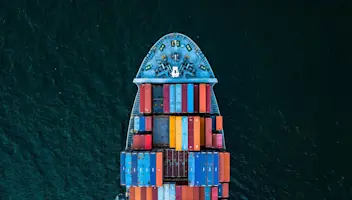Building Better Customer Service in the Age of Amazon: 4 Tips for Your Logistics Company
Building Better Customer Service in the Age of Amazon: 4 Tips for Your Logistics Company
Building Better Customer Service in the Age of Amazon: 4 Tips for Your Logistics Company
11 Jan 2022
Jim Endres
In the logistics game, you know that you need to meet or exceed customer expectations to succeed. The problem is customer expectations for delivery windows are higher than ever due to the “Amazon Effect.”
How can small to mid-size transportation companies compete without the vast resources of retail giants like Amazon? How can you give your customers the ability to manage their deliveries without overworking your team?
The answer to these questions is leveraging the right technology. A nimble routing and scheduling software platform will not only help you achieve more efficient routes, but it will also keep your customers happy. You’ll have fast response times and accurate documentation, which sets up both your drivers and your support team for success.
Your drivers have less paperwork and can capture e-signatures with proof of delivery. Digitized documents means that everyone in the company has access to the same information. Further, your office staff can easily investigate order inaccuracies or missed delivery windows and communicate that information to the customer. Your staff can then resolve any issues quickly, which leads to better service.
Excellence in customer service stems from getting ahead of issues before they arise. It also means that when problems do occur, you deal with them promptly.
In this blog, we discuss how to manage service issues and delight your customers. Here are four actionable tips to get there.
1. Know What Your Customers’ Expectations Are
There is an old saying that if you have a great experience somewhere, you’ll tell a few people. If you have a bad experience, you’ll tell everyone. Think about it. Angry customers will go out of their way to let others know about their experience with a company, so the burden is on you to make sure that you give them a good one. Here’s an interesting statistic. Did you know that only 8% of customers report having a superior experience with their purchase or service? However, 80% of businesses believe that they have given exceptional service. So where is the disconnect here? The disconnect is not knowing what your customers expect from your logistics company. You can offer amazing prices and have the best drivers, but if your crew cannot get to deliveries within set windows, your customers will find a company that will.
Have your sales and service team talk with your current customers, and clearly discuss terms with prospective customers. Not only will this help build better relationships with clients, but you’ll better manage their expectations. It’s always a good idea to talk with your customers regularly, anyway.
For example, let’s say you have a customer that is expanding their store. They are completing renovations at night. They need your team to make deliveries late in the afternoon as opposed to early morning, which was when their previous delivery window occurred. If your team has checked in with them regularly, they’ll know this before the client ever calls your dispatcher. You can then reschedule future deliveries until construction is complete. You have now exceeded that customer’s expectations, simply by taking the time to reach out. Communication is key.
2. Honesty Is (Still) the Best Policy
Yes, that saying is a tired old chestnut, but that doesn’t make it incorrect. Issues with weather, traffic, vehicle breakdowns and accidents are going to arise—it’s part of the transportation business. How your team handles them will set you apart. With routing and scheduling software, you’ll know in real time when problems occur. Then you can have a member of your support team contact the customer immediately and explain the matter.
Sure, the customer might still be unhappy with the delay, but they will be much more willing to work with you if they know ahead of time. It gives the customer time to plan and adjust. Calling them after the fact won’t help, nor will making false promises. Great service is about credibility. If your customer knows that you have met their delivery windows for two years, they will be much more willing to overlook one instance, particularly if the delay is unavoidable.
With routing and scheduling software, your dispatcher can examine the day’s schedule and quickly estimate a new delivery time or day for that customer. At the same time, your driver won’t have to spend hours on the phone trying to get a maintenance issue fixed—your support team will already know and can send someone to assist them.
3. Take Complaints Seriously
Your customers judge your logistics business on one simple factor—your ability to get your customers their goods on time. If you cannot achieve timely deliveries consistently, your customers will go elsewhere. In the modern era, there will always be trolls that will give any business a bad review. But there will be customers out there with genuine complaints, and they need to be addressed or they will leave.
No business likes to deal with unhappy customers, but it’s a way to learn and improve. For instance, maybe your customer tells you that a driver is always late getting to their loading dock.
You investigate the matter and find out that the driver was on time for the delivery but was kept waiting at the loading dock. If you had route optimization software, you could see what happened and whether the driver stuck to the planned route. If the driver had a legitimate reason for changing the route, you’ll know that at the end of the shift, and can change the schedule accordingly. If they didn’t, you can address the issue during a driver debrief.
With routing software, it’s easy to see the planned routes vs. the actual routes and adjust as needed. This means that you can work on a continuous improvement loop and get out in front of complaints.
4. Offer Flexible, Tailored Delivery Options
For modern logistics companies, the customer wants to not only choose their own delivery times but also to choose a time that works best for them. If you are using manual routing processes, it’s going to be impossible to meet these standards. Offering customers morning or afternoon windows is no longer an option.
With advanced routing software, not only can you meet tight time windows, but you can also input any number of variables and restrictions that your customers throw your way. Let’s say you have a restaurant customer that must have deliveries completed by 8:00 a.m. so that there is no disruption to their normal business hours. Or maybe you have a customer that has changed their hours of operation and needs later deliveries.
Routing software can give you the competitive edge because it allows you the flexibility to meet changing customer demands. You only need to enter the customer’s relevant delivery data once and the algorithms will help you meet every customer’s request—in the most efficient and achievable way. If you want to start offering later deliveries, that is possible, also. Because your routes are more efficient, you can have drivers run different shifts to accommodate those clients that want evening deliveries—without having to hire new staff.
Using route optimization software not only expands your client base, but it also ensures that you won’t have to drop your prices to stay competitive. You’ll be able to manage both new and existing customer commitments with the resources you have. And if you need to expand, the software will help you run any number of “what if” scenarios to see if expansion is viable.
Customer service for logistics companies isn’t difficult. It’s about delivering goods to customers exactly when you say you will. And if you cannot meet a delivery window, it’s about communicating the issue promptly. When you do that consistently, you’ll retain long-term customers and win new ones.
Are you ready to elevate your customer service? Aptean can help. Find out how, now.
Related Articles


Ready to start transforming your business?
We've got the specialised TMS solutions you need to conquer your industry challenges.






